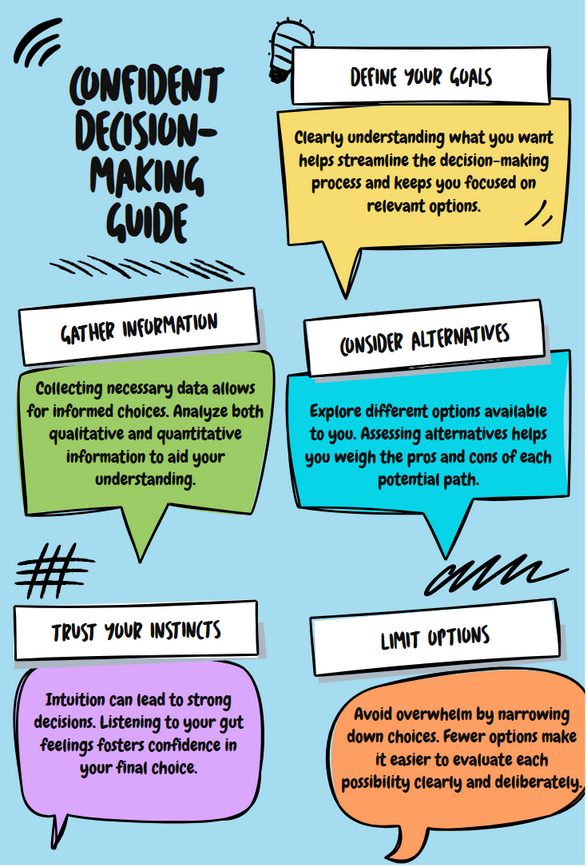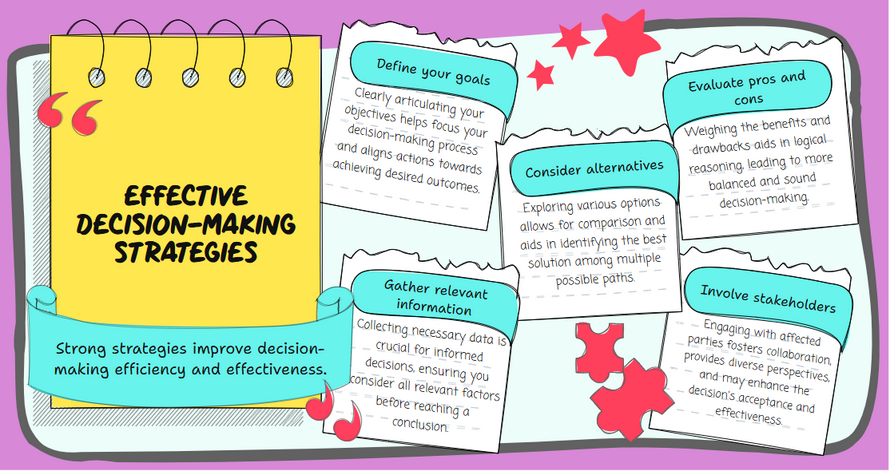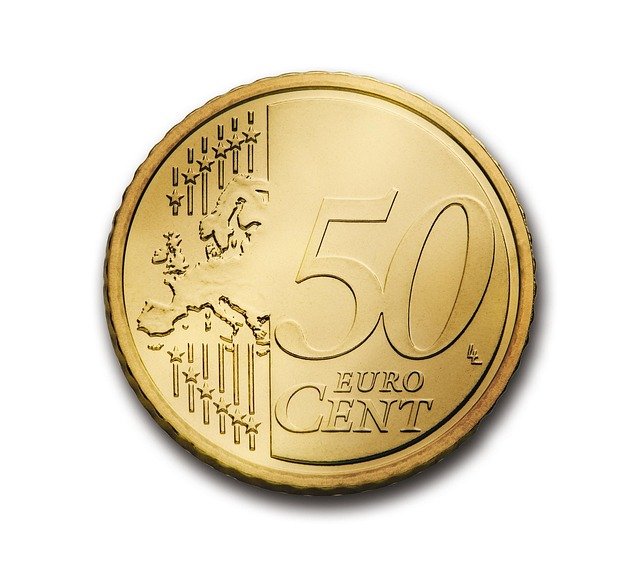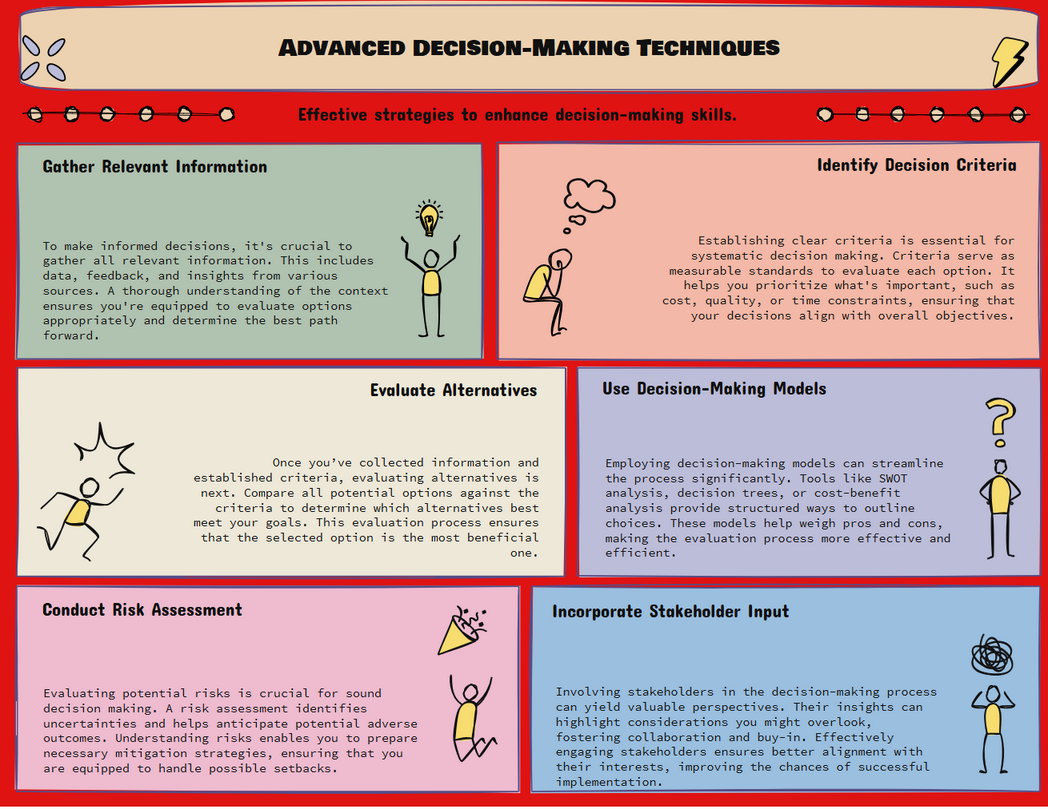
Discover the ultimate guide on how to make a decision with confidence. Learn powerful techniques that transform your mind and lead to better choices.
Introduction
The simple act of making a good decision can change your whole life. Whether you’re trying to decide what to have for breakfast or contemplating a job shift, there are a million mind-blowing methods for making decisions that will help you make more intelligent decisions every single day. These are proven methods that will change how you approach problems and give you the confidence to make decisions that work.
The thinking muscle is just like your muscle – the more you use it, the stronger it becomes. The average person is said to make thousands of decisions every day without even being aware of it. However, for the big decisions that truly matter, many of us feel paralyzed or scared to make the wrong call.
Table of Contents
How to Make a Decision with Confidence and Clarity
Making decisions with confidence and clarity starts with taking a step back and giving yourself time to think. When you rush into choices, you often miss important details that could change everything. Start by writing down what you need to decide and why it matters to you.

Why Good Decision Making Matters.
All successful people share one powerful characteristic: the ability to make good decisions. Strategic thinking is not only for business executives or politicians. It’s an ability that serves you in every area of life.
Look at it this way: Your life at present is the total of all the choices you’ve made to this point. Where you live, who you hang out with, what you do for work, and how you spend your free time are all a result of the choices you’ve made. That is why it is so important for us to learn better ways to make decisions.
Strong strategies for making decisions help you.
Making good decisions is something we all need to do every day, and there are simple ways to get better at it. First, please take a step back and think about what you’d like to achieve before jumping into any choice. Please write down the pros and cons of each option you have, and discuss it with people you trust to gather their thoughts. Give yourself enough time to think things through instead of rushing, because quick decisions often lead to regret later.

The Science Behind Decision Making
Your brain is always on hand to support your decision-making. 2. We use two main systems when making a choice, scientists find. The first system is quick and automatic, helping you make decisions without requiring much thought. The second, slower system is more deliberate and self-conscious; it comes into play when you are forced to think something through.
Cognitive decision-making research has demonstrated that our brains are capable of only so many decisions in a day before they are exhausted. This is what’s known as decision fatigue, and it’s one reason you may feel exhausted after a day in which you’ve made numerous choices.
The good news is that you can teach your brain to make better decisions with some simple tricks and strategies. These techniques enable you to work with the natural processes of your brain, rather than struggling to overcome them.

Decision Fatigue Physically Depletes Glucose in the Brain
Making decisions consumes energy in the form of glucose. Studies have shown that after making numerous decisions, people experience measurable drops in blood glucose levels, which can lead to poorer judgment and increased impulsivity.
Mind-blowing Decision-Making Strategies
Making good decisions doesn’t have to be complicated or scary. One of the best tricks is to sleep on it before making any big choice. When you give your brain time to rest, you often wake up with a more precise answer. Another smart move is to ask yourself what advice you would give your best friend if they were in the same spot. For instance, when I was debating whether to take a new job, I asked myself what I would advise my friend in a similar situation. This helped me see things more clearly, without the worry and stress that cloud your thinking.
The 10-10-10 Rule
This is a simple yet effective decision-making technique. When you’re confronted with a decision, ask yourself: How will I feel about this choice in 10 minutes, 10 months, 10 years?
It allows you to look past the immediate emotions and consider long-term consequences. If you are, say, contemplating quitting your job, you might feel excited 10 minutes after the decision, worried 10 months later, and grateful 10 years on if your new endeavor leads to a better career.
How to use it:
- Write down your decision
- Think about the 10-minute feel (during and moments after)
- Consider the 10-month (short-term) repercussions.”
- Consider the 10-year outcome (not a platitude)
- And just decide based on what’s important to you
The Devil’s Advocate Method
This is a logic-based approach of reasoning against one’s first intuition. If you’re tilting in one direction, try to force yourself to look for the strongest possible reasons why the opposite choice might make more sense.
This technique is particularly valuable in situations where you need to make an “enormously important decision” and ensure you’ve considered all options. It allows you to pick up potential problems before they occur and ensures you’re not merely following your gut without thinking something through.
Steps to follow:
- Identify your preferred option
- List out at least five reasons why this option might not be correct
- Research evidence for the opposing view
- And see if any of these arguments are convincing to you.
- Good luck with the decision you have to make; you will have to make it with a clear understanding of the risks involved.
The Coin Flip Technique

The Method Works Best for Emotional, Not Logical Decisions
While people often use coin flips for trivial choices, the technique is most effective for decisions where logic alone feels insufficient, such as choosing between job offers or making relationship decisions. When analytical thinking reaches its limits, the coin flip taps into emotional intelligence and intuitive knowledge, which is the ability to understand something immediately, without the need for conscious reasoning. This is something that rational analysis may overlook.
This isn’t about leaving things to chance. Rather, it is about using your reaction to the drop of the coin to figure out what you want. Notice how relieved, or disappointed, you are when you flip a coin and heads comes up.
Good decision-making generally starts with aligning with your true desires, and this practice helps you tune into your subliminal wants. What you feel when you learn how the coin toss went gives you a better answer about what the science has already decided than you will get from hours of sober dissection of priors and utilities.
The Two-List Strategy
Popularized by Warren Buffett, this technique requires two lists.
Step 1: Write Out Your Best Options Or Priorities For Your Life.
Step 2: Now, encircle the most important of them. Everything that wasn’t circled, you add to the list of things you want to avoid.
This process of decision-making ensures that you focus on what is truly important to you without getting sidetracked by seemingly easier options. It’s beneficial for making career-defining decisions, setting goals, and managing time effectively.
Implementation steps:
- List of everything you could do, or what’s most important.
- Highlight, circle, or underline the top 3-5 most crucial.
- Add everything else to your “avoid” list
- Only concentrate on those circled ones.
- Review and adjust periodically
The Sleep On It Approach
Your brain is still solving problems for you, even when you aren’t actively considering them. However, sometimes your intuition is more effective when you allow your subconscious time to process the information.
Studies demonstrate that (deep) complex action decisions are more accurate when this policy is made. While you sleep, your brain consolidates information and forms new associations that can help you in seeing things more clearly the next day.
Best practices:
- Day by day, get all the required information
- Suggest a specific time you make the decision (the next morning)
- Avoid overthinking before bed
- Trust your morning clarity
- Grab a pen and jot down what your mind has to say. Write down your ideas as soon as you wake up.
The Assumption Reversal Method
This is an analytical approach to decision-making, where you identify your core assumptions on a topic and consider what would happen if those assumptions are, in fact, incorrect.
For example, you’re considering starting a company and think you need a substantial amount of money to get started. But what if you flipped that assumption on its head? What if you could begin with very little money? And that, then, leads to creative solutions you’d never have thought of.
The Pre-mortem Analysis
Rather than waiting for disaster, suppose your decision has already collapsed. Work backward to decide what might have caused the failure. This way, you can identify potential issues and organize yourself proactively.
This risk assessment methodology is employed by some of the most successful companies and people to make better decisions. By imagining what might go wrong, you can either select a different path or set some fallback strategies.
Advanced Decision-Making Techniques

Studies of the psychology of behavioral decision-making have identified a variety of sophisticated techniques that can help you make even better decisions.
- Edward de Bono has developed the Six Thinking Hats, which allows you to examine a decision from six distinct viewpoints: facts, emotions, caution, a positive perspective, creativity, and process. This helps you avoid leaving any stones unturned before making significant decisions.
- Multi-criteria decision analysis is ideal for making complex decisions involving multiple factors. Full Article: You list all the important aspects, give them weights according to their importance, and score each option on each factor. By incorporating this mathematical strategy, you remove emotion from the equation and make more impartial choices.
- You want to 80/20 it, or what we call Pareto analysis. In many cases, 20% of your choices contribute to 80% of your outcomes; therefore, recognizing and becoming proactive about those high-impact decisions is important.
Types of Group Decision-Making Errors: Common Group Decision-Making Errors to Avoid
Even with some great strategies, people still make predictable mistakes. The psychology of decision making reveals several common traps:
- Analysis paralysis occurs when you spend so much time analyzing your options that you never make a decision. Give yourself deadlines and meet them.
- Confirmation bias causes you to seek information that confirms what you already believe and to ignore evidence that doesn’t fit with your existing view. And always actively look for the other side.
- The sunk cost fallacy deceives you into persisting with bad decisions because you have already invested time, money, or effort. Learn when to cut your losses on something that isn’t working.
- Overconfidence can lead to poor decisions if you believe you know more than you do. Challenge yourself constantly and solicit diverse perspectives.
Building Better Decision-Making Skills
It doesn’t have to be hard to learn how to make decisions. You can improve at them by practicing and thinking about them every day.
- Start keeping a decision journal. Record major decisions and the reasoning behind them, along with their results. With time, you’ll recognize patterns in your thinking and areas to grow in response.
- Practice making small decisions quickly. It helps build your confidence by saving mental energy for important decisions, allowing you to reserve your best thinking for what truly matters.
- Analyze those decisions of the individuals you admire. Study biographies, case studies, and interviews to learn how successful people make difficult decisions.
- Be kind to yourself. You will make mistakes because you are human. Every time you make a mistake, it’s a valuable learning experience that helps you make the right choices in the future.
Conclusion
Waste of time! These final, mind-blowing decision-making strategies are like having a full toolkit to use on various types of choices in your life. Please note that you will become more skilled at making choices. Try one or two of these with smaller decisions first and gradually apply them to bigger decisions over time.
The secret lies in identifying the strategies that work best for your personality and your circumstances. Some people find intuitive methods easier, while others prefer analytical approaches. Experiment with some of the strategies and construct your decision-making method.
What decision are you currently making that would benefit from these strategies? Choose one method from this guide and give it a try today. Your future self will be grateful that you are making the extra effort to make more informed choices.
